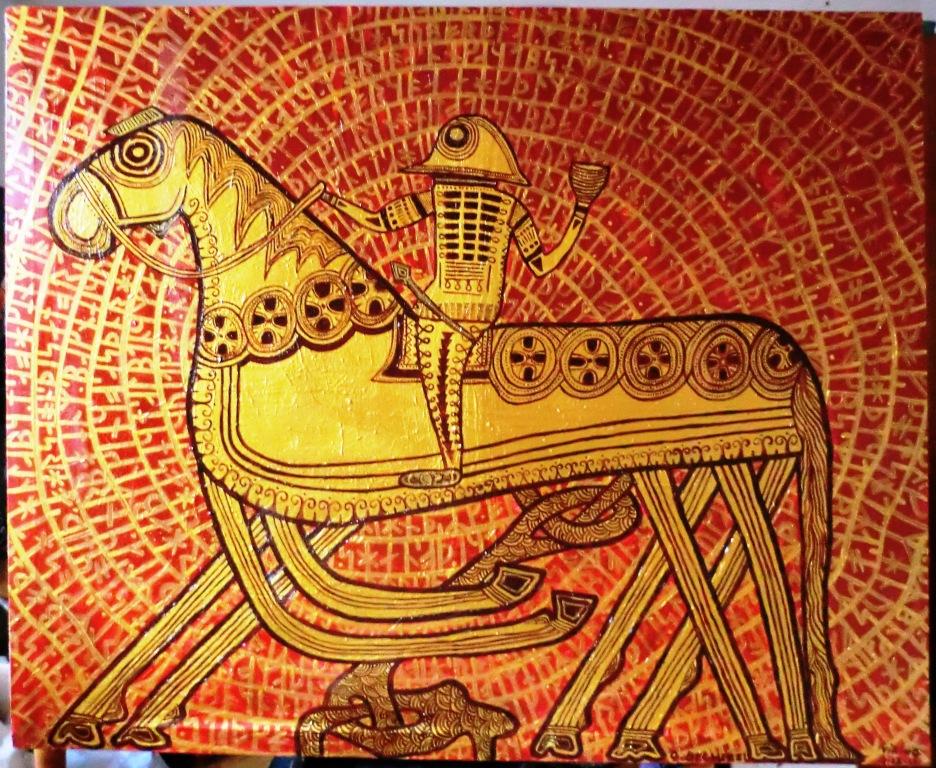In the frost-covered landscapes of Scandinavia, where winter winds whisper ancient tales, horses galloped not only across physical terrain but through the very fabric of Norse mythology. These magnificent creatures were far more than mere transportation in the Norse worldview—they were sacred beings, companions to gods, and symbols of power that transcended the boundary between Midgard and the realms beyond. From Sleipnir’s eight legs racing across the rainbow bridge to the fiery steeds pulling the sun’s chariot, horses embodied supernatural forces and cosmic significance. Their presence in Norse myths reveals much about how the Norse people understood their world, their gods, and the delicate balance between chaos and order. This exploration will take us through the rolling mythological landscapes where divine horses shaped the destiny of gods and humans alike.
Sleipnir: Odin’s Eight-Legged Steed
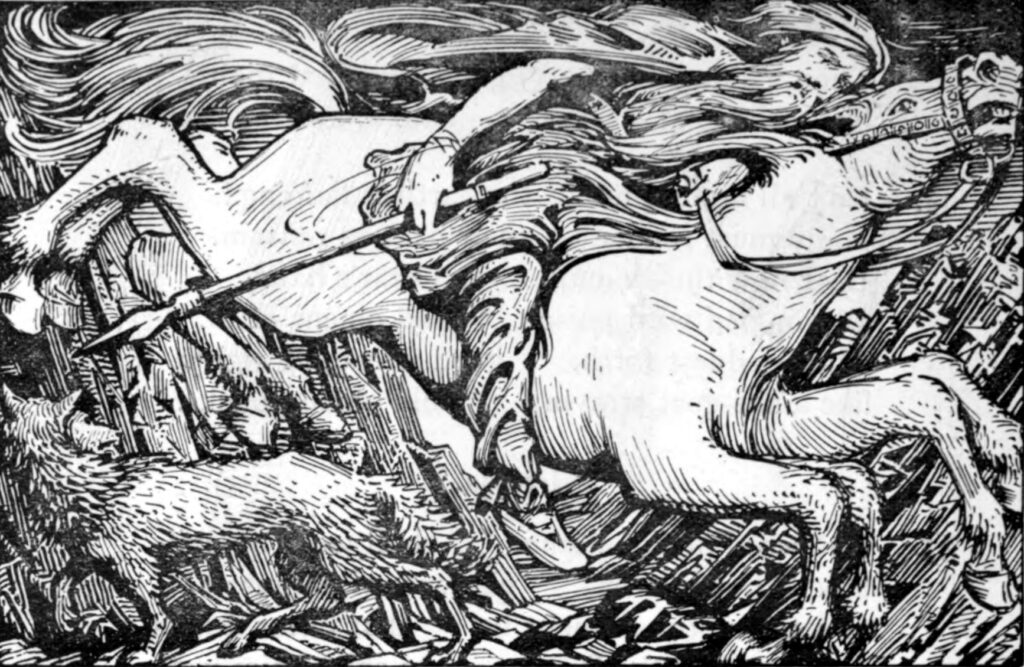
Perhaps the most famous horse in Norse mythology is Sleipnir, the eight-legged steed belonging to the Allfather Odin. Born from the trickster god Loki (who had transformed himself into a mare) and the giant stallion Svaðilfari, Sleipnir’s unusual birth resulted in his extraordinary appearance and abilities. His eight legs symbolized ultimate speed and stability, allowing him to gallop across the sky, over water, and even between the Nine Worlds of Norse cosmology. Sleipnir was essential to Odin’s role as a wanderer and seeker of wisdom, carrying him to places no ordinary horse could reach, including the underworld Hel where Odin sought knowledge about Ragnarök. The gray coat of this supernatural steed was said to shimmer with otherworldly light, marking him as a creature between realms.
The Divine Origin of Horses in Norse Creation Myths
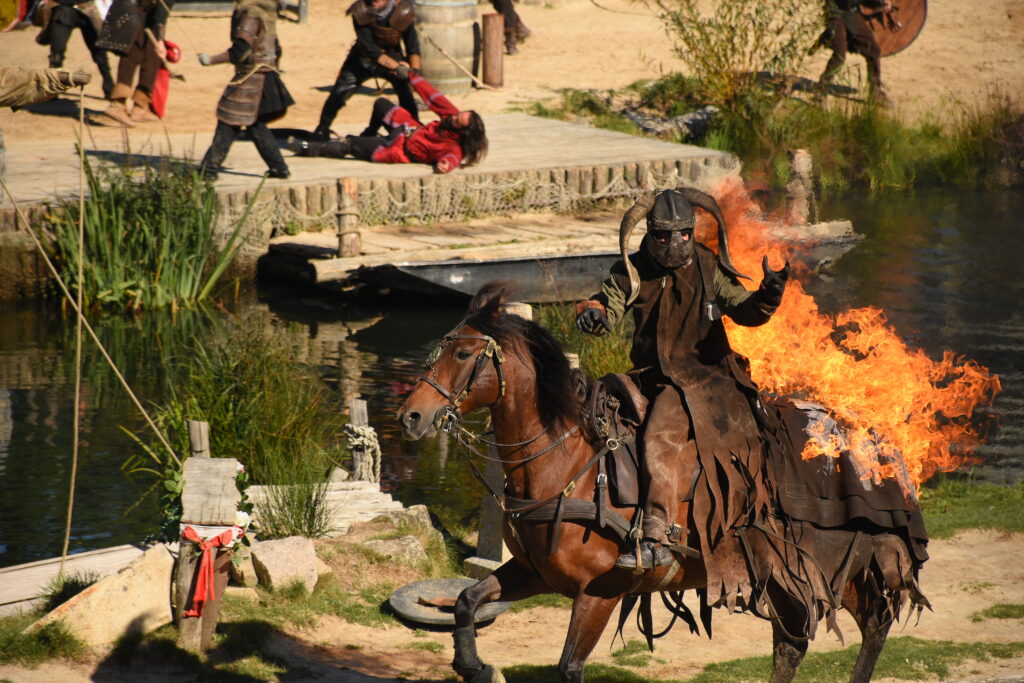
According to Norse creation mythology, horses were not simply domesticated animals but beings with cosmic origins. The primordial world featured four horses—Árvakr (Early Waker), Alsviðr (All Swift), Hrímfaxi (Frost Mane), and Skinfaxi (Shining Mane)—who played critical roles in maintaining cosmic order. These horses weren’t created through conventional means but emerged from primordial forces at the dawn of creation. Their presence in creation myths indicates their fundamental importance to the Norse understanding of the universe’s structure and functioning. The Norse believed these divine equines preceded even some of the gods, making them among the oldest beings in the cosmos and essential to its proper functioning from the very beginning.
Horses of Day and Night: Skinfaxi and Hrímfaxi
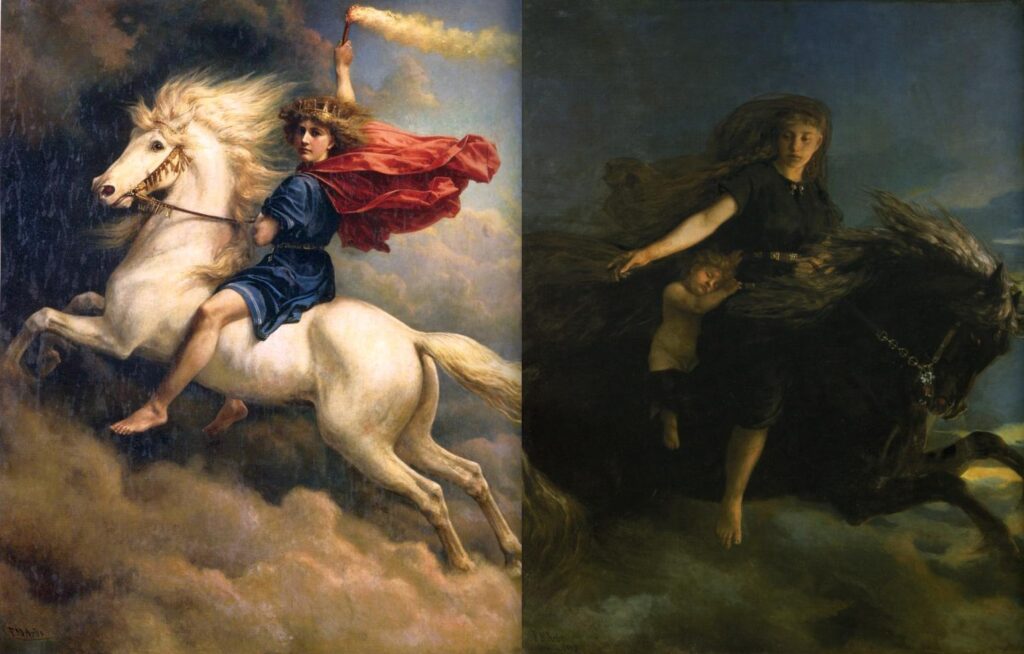
The cycle of day and night in Norse mythology was maintained by two cosmic horses with opposing yet complementary roles. Skinfaxi, whose name means “Shining Mane,” pulled the chariot of Dagr (Day), and his radiant mane illuminated the sky and earth with light as he traveled across the heavens. His counterpart, Hrímfaxi (“Frost Mane”), drew the chariot of Nótt (Night), and the dew that fell to earth each morning was said to be the foam that dripped from his frost-covered bit as he worked through the night. These horses embodied the essential duality at the heart of Norse cosmology—the eternal cycle of light and darkness, warmth and cold. Their reliable journey across the sky provided structure to both divine and human existence, symbolizing the predictable yet sacred rhythms of time that governed life in the harsh northern climate.
Horses as Psychopomps: Guides to the Afterlife
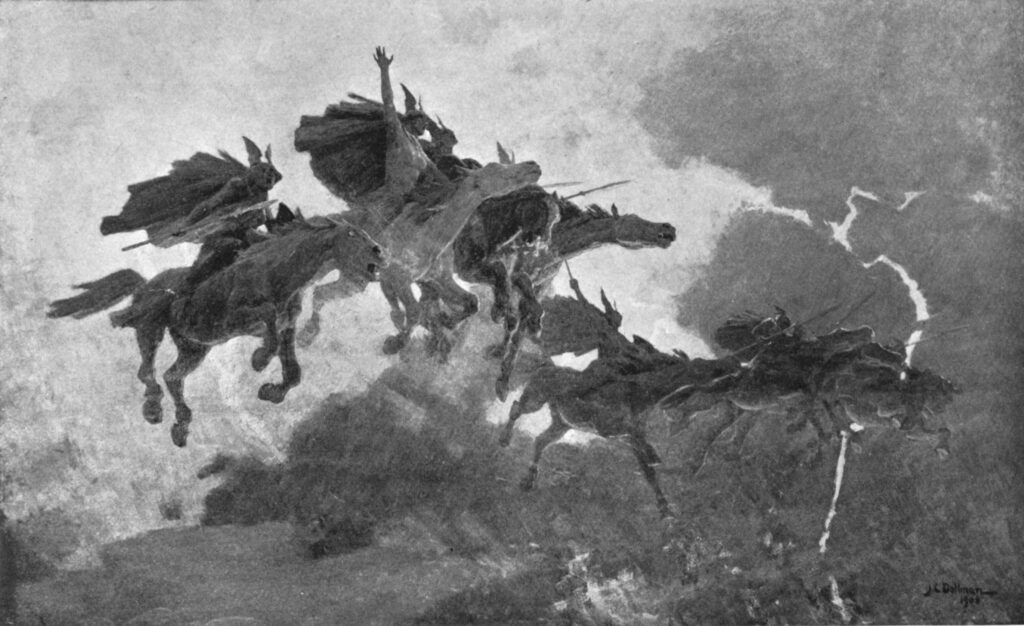
Horses in Norse mythology frequently served as psychopomps—spiritual guides that escort newly deceased souls to the afterlife. This function appears repeatedly in archaeological evidence, particularly in burial practices where horses were often sacrificed and buried alongside important individuals. The horse was believed to carry the deceased on the difficult journey to the appropriate afterlife realm, whether that be Hel, Valhalla, or Fólkvangr. This psychopomp role was especially evident in the practice of ship burials, where horses were sometimes included alongside the ship to help transport the dead across cosmic waters. The association between horses and death journeys was so strong that in some Norse traditions, seeing certain horses or hearing their hoofbeats was considered an omen of approaching death.
The Sun’s Steeds: Árvakr and Alsviðr
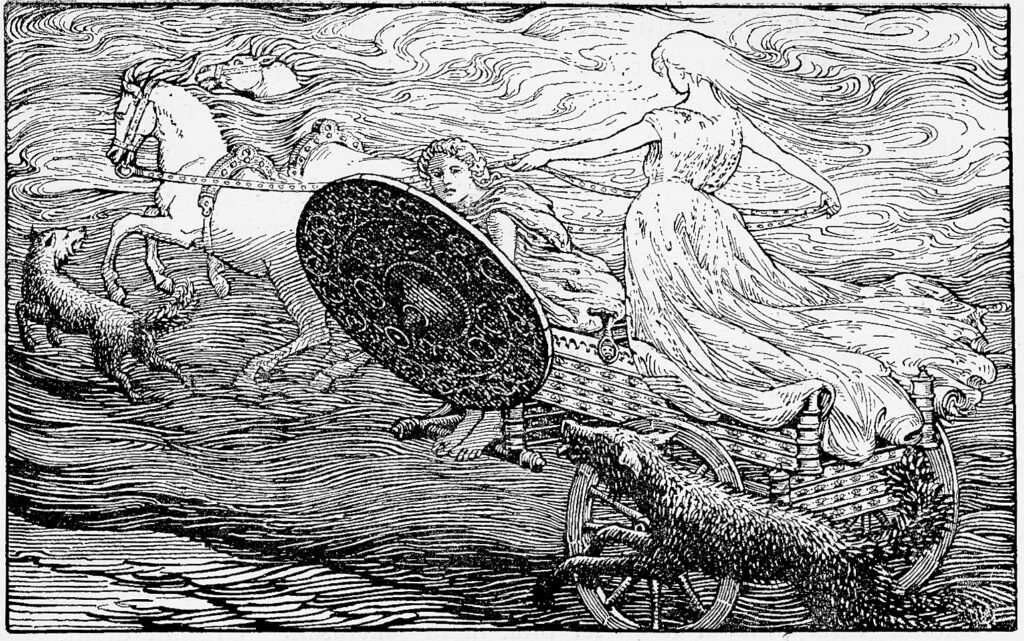
The sun goddess Sól rode across the sky daily in a chariot pulled by two magnificent horses named Árvakr (“Early Awakener”) and Alsviðr (“All Swift”). These tireless steeds had the extraordinary responsibility of pulling the sun itself through the heavens, maintaining the cosmic order upon which all life depended. To protect these vital horses from the sun’s intense heat, the gods placed magical cooling irons beneath their shoulder blades. Despite their supernatural endurance, these horses faced constant danger from Sköll, the wolf who pursued them daily, seeking to devour the sun. Their eventual fate was tied to Ragnarök, when Sköll would finally catch and consume the sun, bringing an end to their eternal journey across the sky.
Horses in Viking Funeral Practices
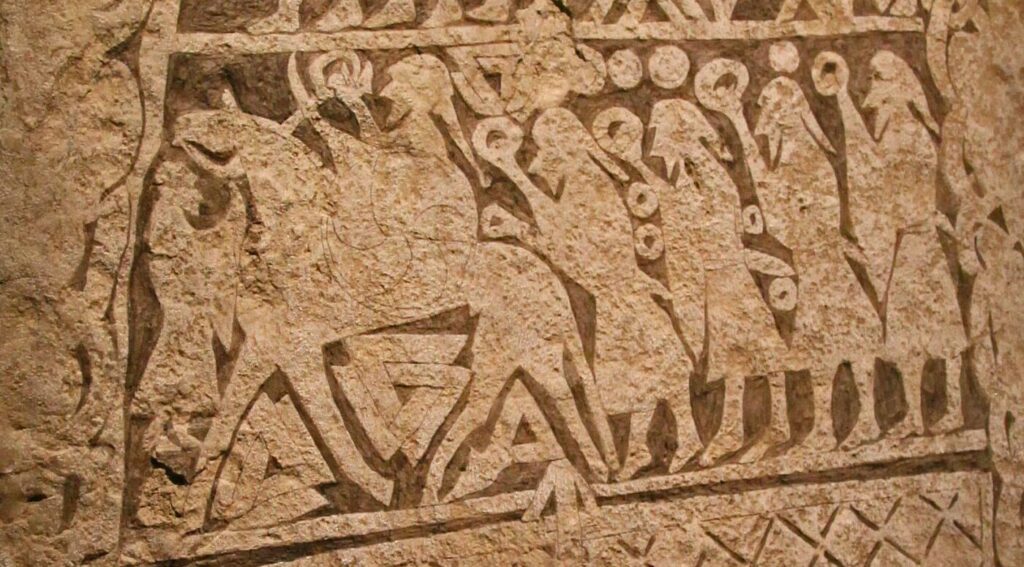
Archaeological discoveries throughout Scandinavia have revealed the prominent role horses played in Viking funeral rites, directly reflecting their mythological significance. Excavations at sites like Oseberg and Gokstad in Norway uncovered elaborate ship burials where horses were sacrificed to accompany high-status individuals to the afterlife. These horse burials weren’t limited to a single region but appeared throughout the Viking world, from Ireland to Russia, underscoring their pan-Norse cultural significance. The position and treatment of the horse remains often suggest they were killed as part of the funeral ceremony, sometimes with rich harness decorations still in place. This practice represented a significant economic sacrifice, as horses were valuable possessions, indicating the depth of belief in their spiritual necessity for the deceased’s journey to the next world.
Freyr’s Magical Horse Blóðughófi
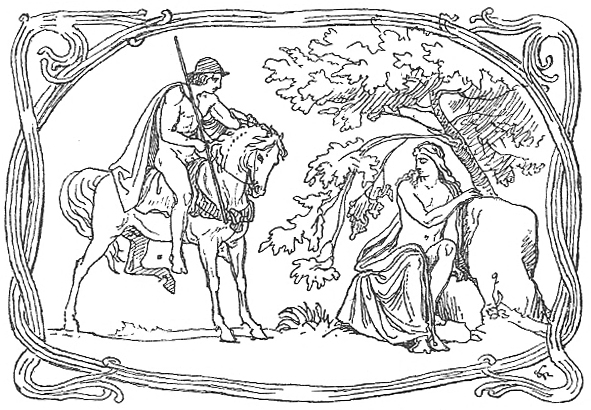
The fertility god Freyr possessed a remarkable horse named Blóðughófi, which translates to “Bloody Hoof” in Old Norse. This divine steed could run through fire and water without harm, serving as both transportation and protection for its divine master. According to some tales, Blóðughófi was not merely a mount but a companion who helped Freyr distribute fertility and prosperity throughout the Nine Worlds. The horse’s name has been interpreted various ways—some scholars suggest it referred to the redness of its legs or hooves, while others connect it to sacred blood sacrifice associated with fertility cults devoted to Freyr. In some traditions, Blóðughófi could also run through the air, making him one of several supernatural flying horses in Norse mythology.
Helhest: The Three-Legged Horse of Death
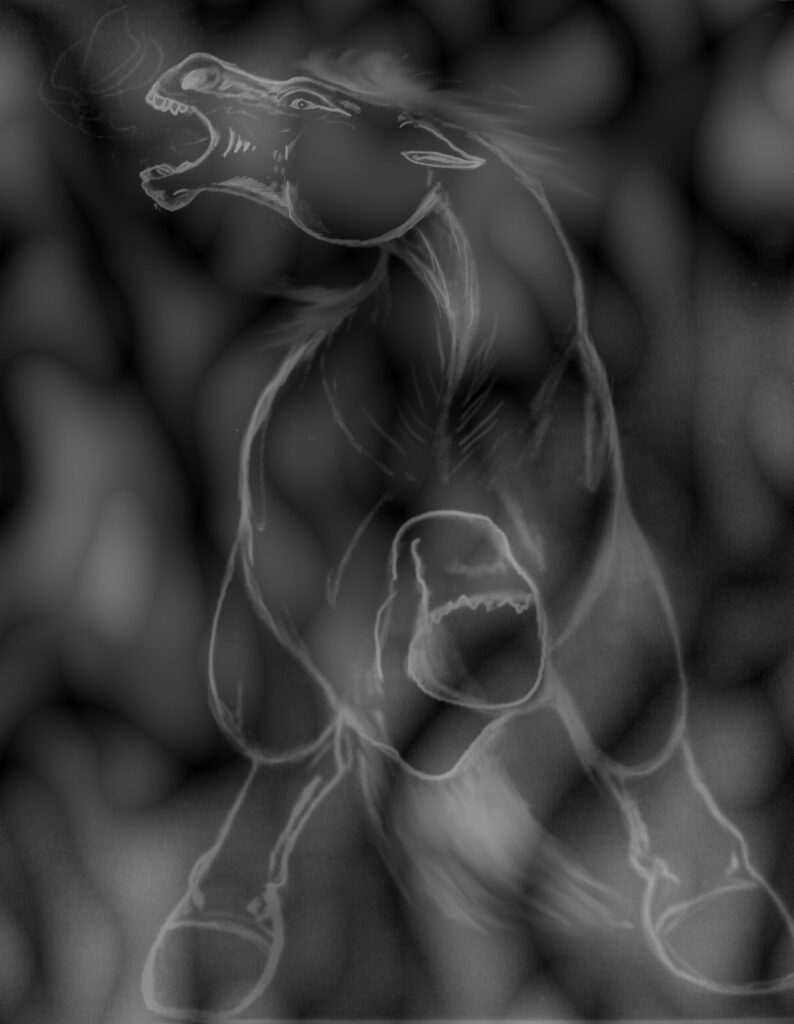
Among the more sinister equine figures in Norse mythology stands Helhest, the three-legged horse associated with death and disease. Often described as pale white or gray, this ghostly creature was believed to be a harbinger of plague and misfortune. According to folk traditions that evolved from earlier Norse beliefs, seeing Helhest—particularly at churchyards—was an omen that death would soon visit the community. The distinctive three-legged appearance of Helhest created an unnatural, discomforting gait that emphasized its otherworldly nature. In some later Scandinavian folklore, Helhest became associated with the goddess Hel herself, serving as her personal mount as she collected souls for her cold realm beneath the roots of Yggdrasil.
Horses as Symbols of Nobility and Power
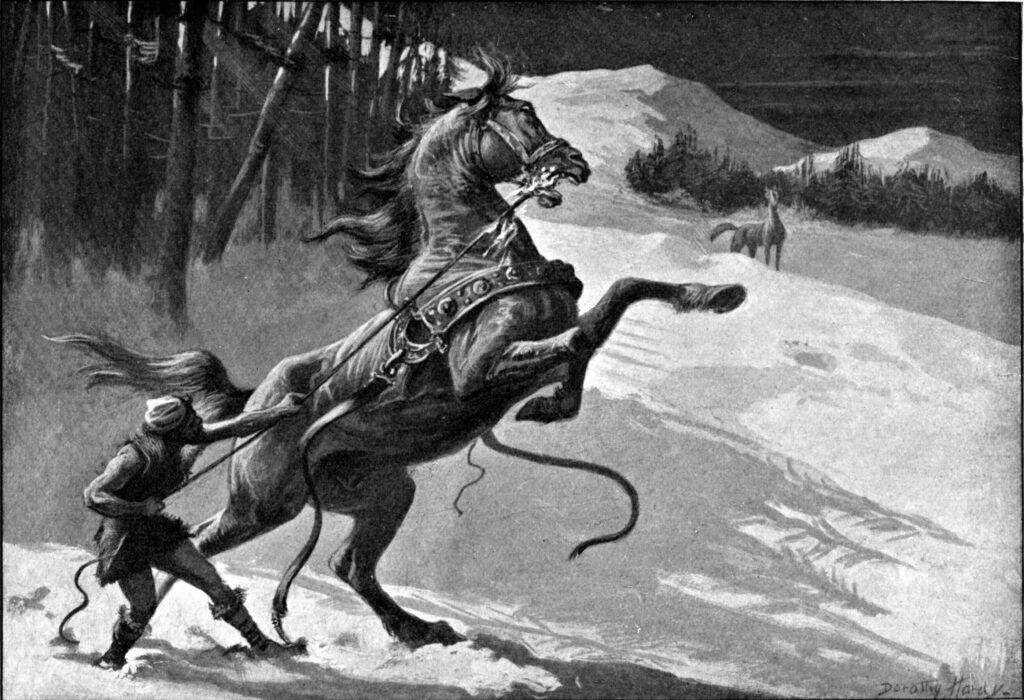
Beyond their mythological roles, horses in Norse culture represented status, wealth, and power among both gods and humans. The gods most frequently depicted with horses—Odin, Freyr, and Thor—were among the most powerful and respected deities in the pantheon. For human nobility, owning fine horses was essential to maintaining status, and horse breeding was considered a noble pursuit worthy of jarls and kings. This connection between horses and power extended to warfare, where mounted warriors held elevated social status. The symbolic value of horses was further evidenced in place names throughout Scandinavia that incorporate horse elements, suggesting locations where horses were bred, trained, or held special ritual significance.
Horse Sacrifices in Norse Religious Practices
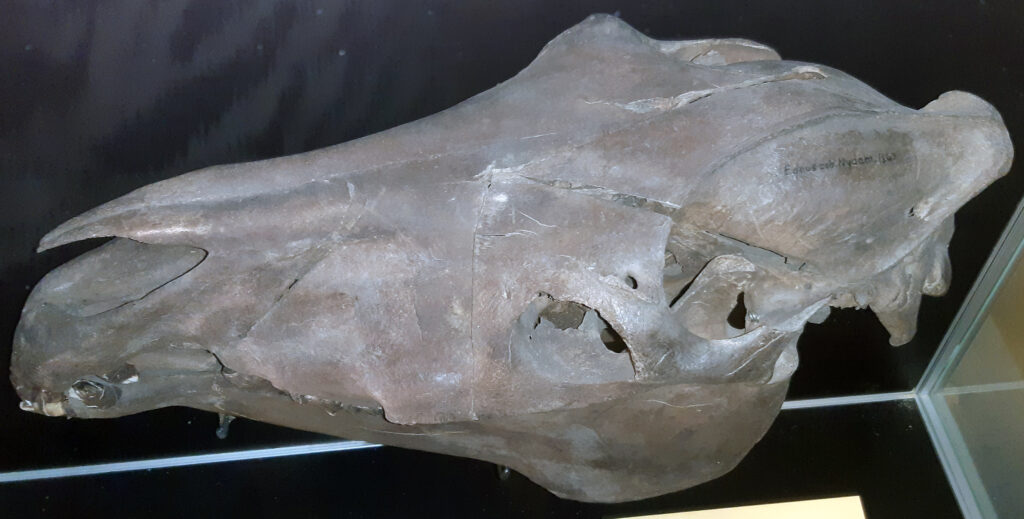
Horse sacrifices (blót) represented one of the most sacred ritual practices in pre-Christian Norse religion. Historical sources, including Adam of Bremen’s account of the temple at Uppsala, describe elaborate ceremonies where horses were sacrificed and their blood collected to bless participants and sacred spaces. These rituals typically occurred during major festivals, particularly those associated with fertility and harvest. The meat from sacrificed horses was often consumed in ritual feasts that followed the sacrifice, though this practice became one of the most controversial aspects of Norse religion as Christianity spread through Scandinavia. Horse sacrifices were particularly associated with the worship of Freyr and Odin, with different ritual purposes—Freyr’s horse ceremonies focused on fertility while Odin’s connected to warfare and death.
Grani: The Loyal Steed of Sigurd
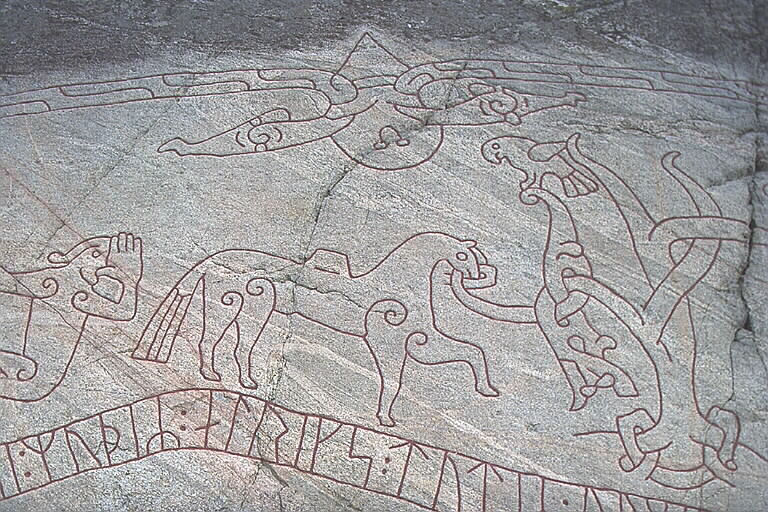
While strictly speaking a part of heroic legend rather than deity-centered mythology, the story of Grani, Sigurd’s faithful horse, holds an important place in the Norse mythological tradition. Descended from Sleipnir himself, Grani inherited supernatural abilities from his divine ancestor, including extraordinary strength and intelligence beyond ordinary horses. Grani demonstrated his exceptional nature when only he could carry the treasure of the dragon Fafnir after Sigurd slew the beast. The close bond between Sigurd and Grani exemplified the Norse ideal of partnership between warrior and steed, becoming a model emulated in both stories and real-life relationships between Norse warriors and their horses. Some versions of the tale suggest Grani understood human speech and mourned deeply when his master was killed, refusing to be ridden by anyone else.
Horses and the Wild Hunt
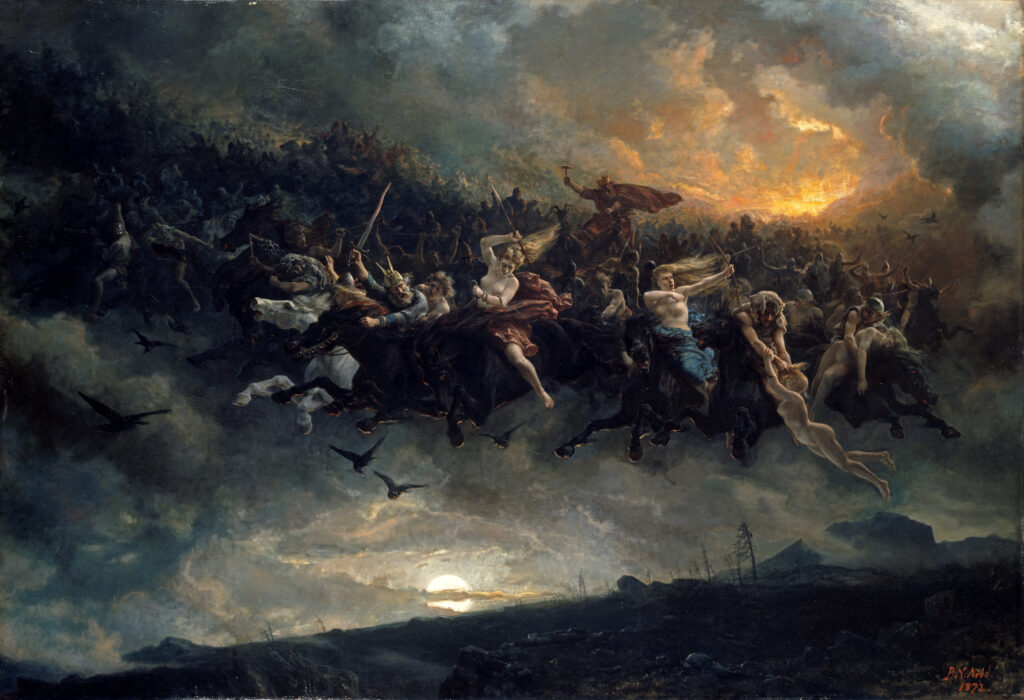
One of the most terrifying supernatural phenomena in Norse mythology was the Wild Hunt—a ghostly procession of hunters riding across the storm-filled sky, led by Odin himself astride Sleipnir. This spectral cavalcade featured numerous horses carrying the souls of the dead, creating a thunderous sound as they rushed through the night air during winter storms. The appearance of the Wild Hunt was considered an omen of catastrophe—war, plague, or the death of whoever witnessed it. The horses of the Wild Hunt were described as black, with flaming eyes and nostrils that breathed fire or steam, emphasizing their supernatural and fearsome nature. This mythological motif survived well into Christian times in Scandinavia, evolving but retaining its core elements of spectral horses and riders moving supernaturally through the night sky.
Horses at Ragnarök: The Twilight of the Gods
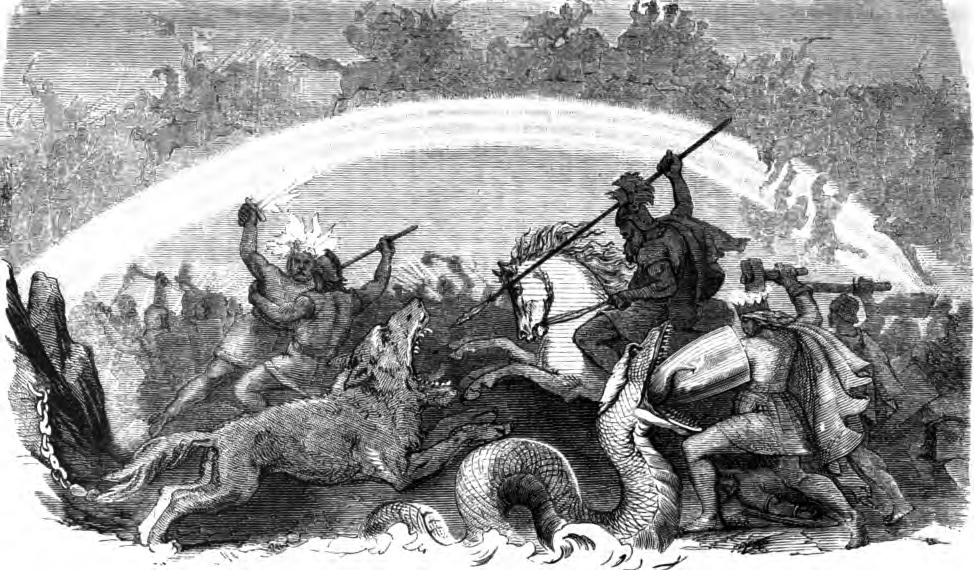
In the apocalyptic battle of Ragnarök, horses play significant roles both as companions to the gods and as symbolic elements of cosmic destruction. Odin rides into battle on Sleipnir, leading the einherjar (fallen warriors) against the forces of chaos. The sun and moon horses meet their end when cosmic wolves finally catch and devour their charges, plunging the world into darkness. Some accounts mention that Freyr rides Blóðughófi into his fatal battle with the fire giant Surtr, where both god and steed perish. After the world’s destruction and subsequent rebirth, horses appear again in the renewed world, suggesting their essential nature to cosmic order even beyond the current cycle of existence.
Archaeological Evidence of Horse Veneration
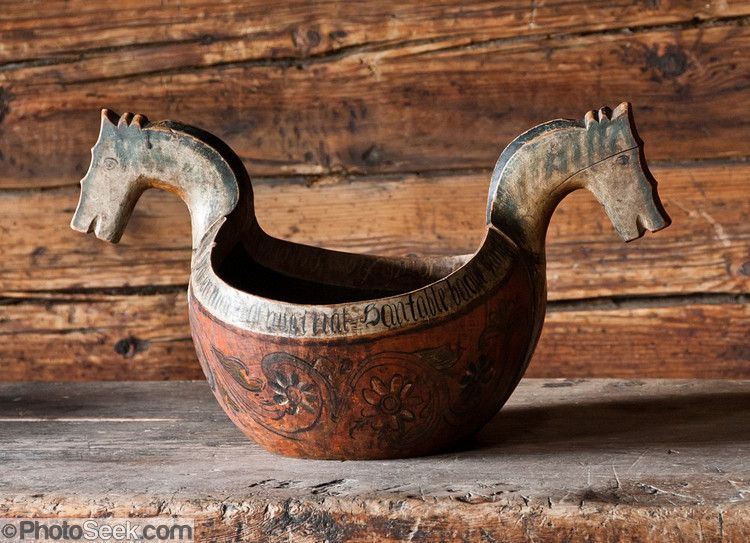
Archaeological discoveries throughout Scandinavia and Viking settlements abroad have provided tangible evidence of the sacred role horses played in Norse culture. Horse pendants, figurines, and decorative elements on everyday objects suggest their symbolic value extended beyond myth into daily life. Particularly notable are the numerous horse-shaped amulets found in grave sites, indicating their protective function continued even after death. Carved wooden horse heads from ship prows demonstrate how the symbolic power of horses extended into maritime culture despite horses having no practical function at sea. Perhaps most telling are the elaborate bridles and horse equipment found in high-status burials, often decorated with religious motifs linking the practical use of horses with their mythological significance.
Conclusion
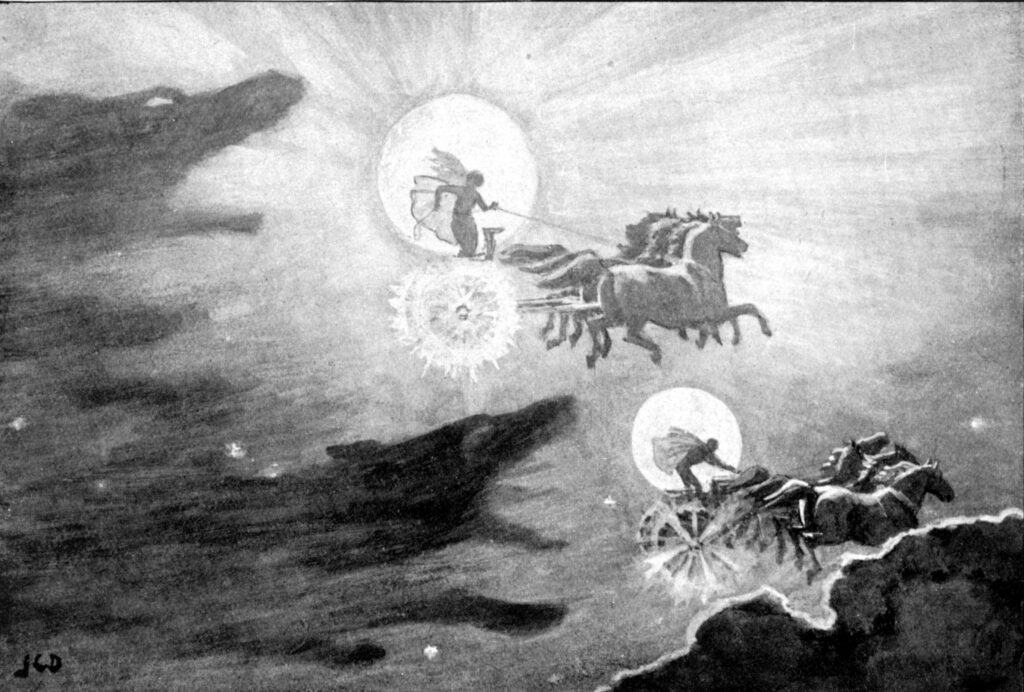
The profound integration of horses into Norse mythology reflects their essential role in both the cosmic order and everyday Viking life. Far more than beasts of burden, these magnificent creatures carried gods between worlds, maintained the cycle of day and night, and accompanied the dead to their final destinations. Their supernatural abilities—from Sleipnir’s eight legs to the sun horses’ eternal endurance—symbolized forces beyond human comprehension. As civilization in the North evolved, these mythological horses galloped from pagan belief into folklore, literature, and art, their hoofbeats still echoing through the cultural landscape of Scandinavia today. The Norse understanding of horses as beings of power, mystery, and divine connection offers us insight into a worldview where the natural and supernatural constantly intertwined, and where the humble horse stood proudly at the intersection of human aspiration and divine power.

